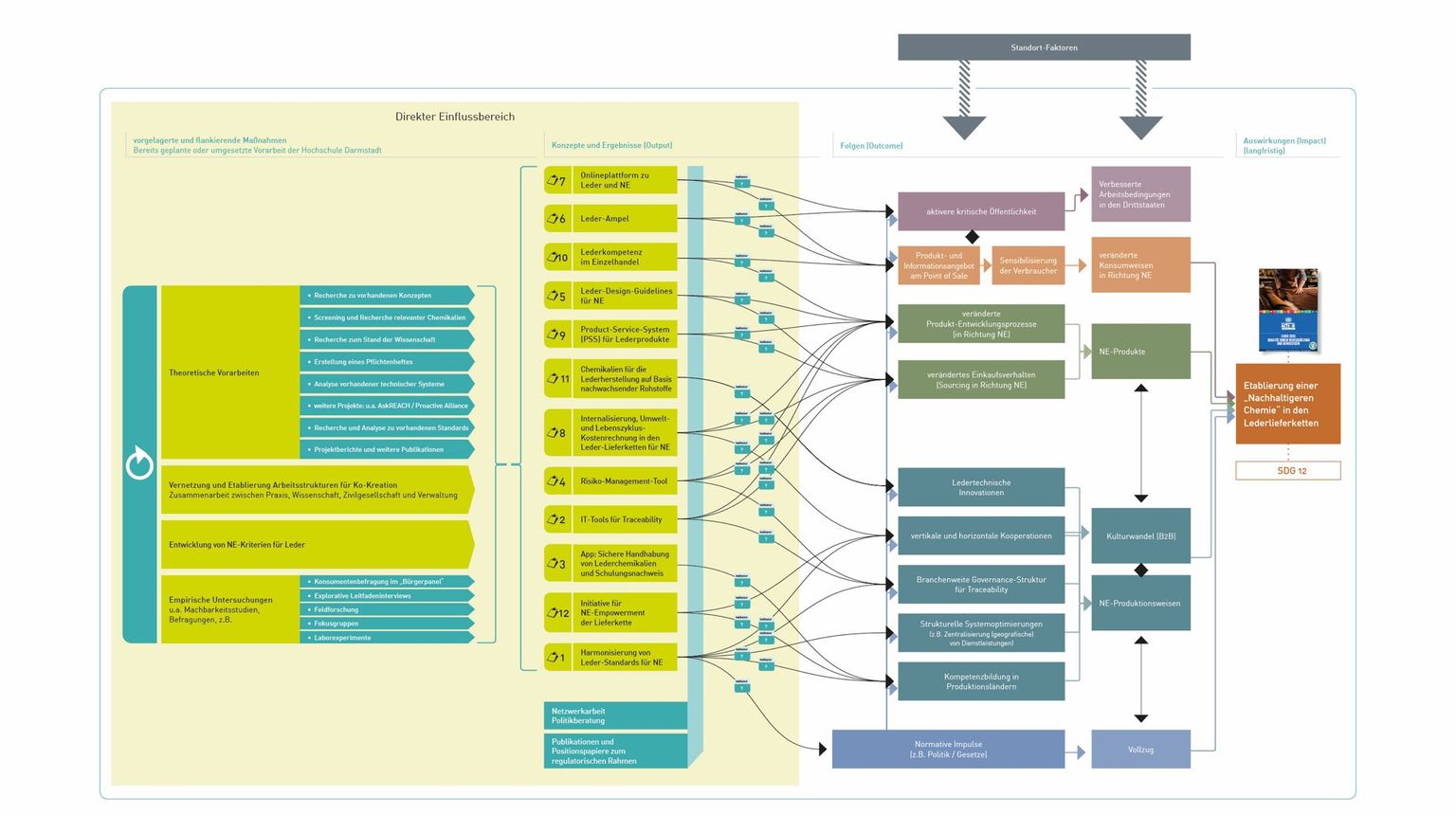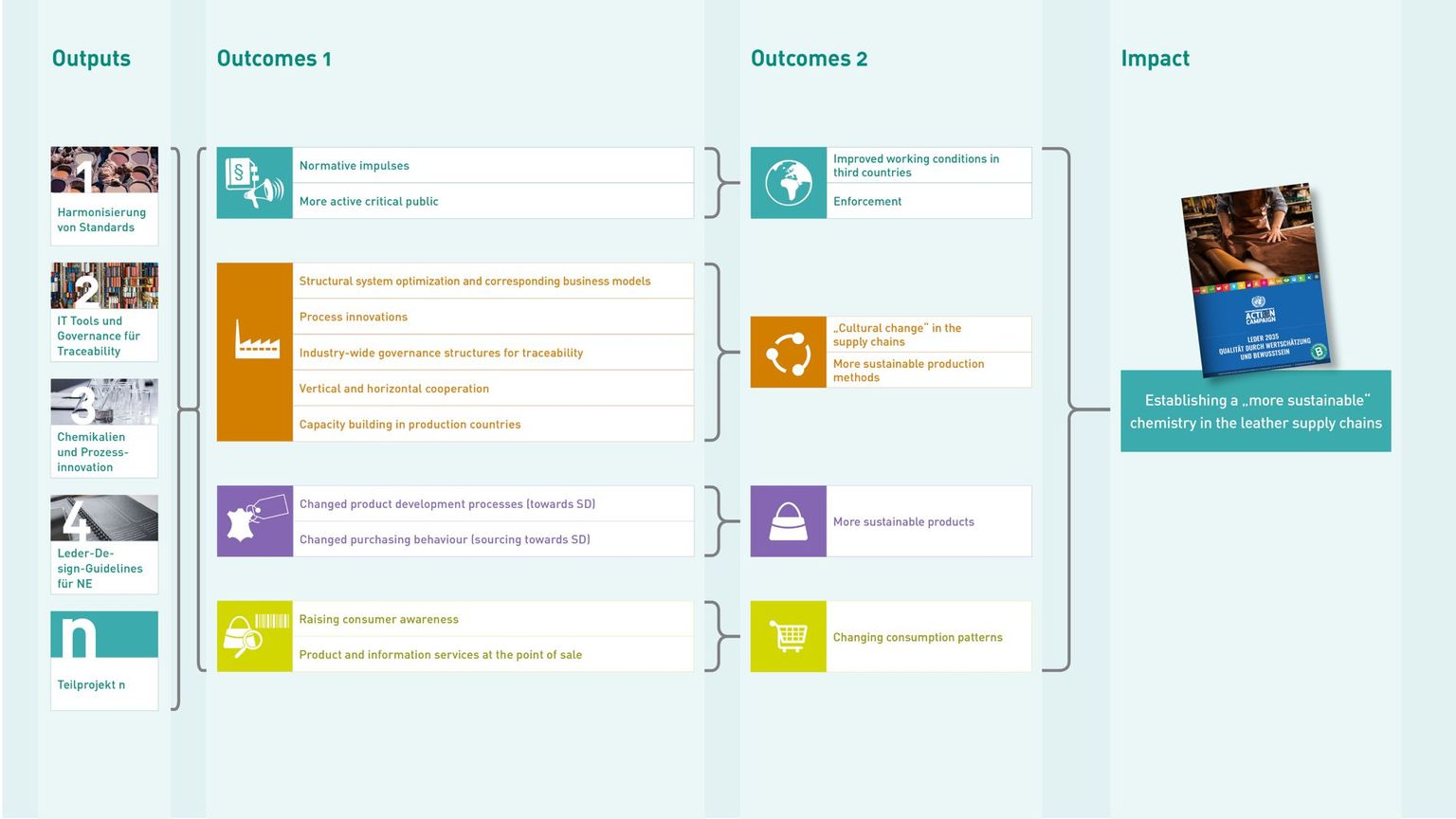A Theory of Change (ToC) supporting the visioning of a sustainable supply chain
Context
This report shares experience on the use of a Theory of Change (ToC) as a means for structuring and communicating a transdisciplinary project aiming at more sustainable chemistry in the global leather supply chains (as part of the project “system innovation for sustainable development – s:ne”). The method was applied to complement two preceding methods. In an extensive 9-month participatory process for scenario building and strategy development (roadmaps) with representatives from the leather supply chains, a narrative in form of a scenario story had been developed, but the project team lacked of a structured plan and systematic logic about what were the most important and urgent steps to be taken by all project partners. The roadmaps were too broad and not concrete enough to solve this.
Purpose
With the ToC as a tool and framework we aimed at structuring the project trajectory and prioritizing tasks and subprojects internally as well as externally. The preceding scenario building process already produced a vision for the year 2035 and a strategy workshop yielded a large number of possible subprojects and paths to take. Therefore, the ToC was – in this case – less focussed on creating a shared vision or ideating certain steps and tasks but rather to, based on the bigger picture of the overall project goal, understand the role and effect of the possible future subprojects as well as steps already taken.
In addition, the ToC puts the scenario vision on a more valid basis, for example by defining impact paths and thus clear implementation structures. It therefore makes the scenario narrative more plausible and persuasive. By visualizing parallel paths of action, the ToC also makes potential conflicts of objectives transparent. Logical gaps and missing steps of the overall planning become obvious. All in all, it thus helps all actors involved to better reflect and align with the project goals
Procedure applied
While the typical procedure of developing a ToC starts with steps such as defining the overall purpose, identifying factors having a major influence on that purpose as well as main activities, many of these steps had already been completed in the previous scenario building process. Therefore, the procedure applied in this project started by sorting and structuring the results of the scenario building process using categories such as “outputs”, “outcomes” and “impact” and subsequently merging them into a ToC illustration.
1. Initial layout and challenges
In a series of interdisciplinary workshops with a group of researchers we used whiteboards, sticky notes and yarn to illustrate causalities, interdependences and chronologies between the elements of the ToC derived from the scenario building. This process can be described as iterative and discursive as the task of defining orders and hierarchies in the ToC turned out to be a challenging but at the same time clarifying process for the project team. Representatives from the leather supply chains did not participate in these workshops mainly due to a lack of time resources and the need to increase efficiency of the entire process. We later invited these actors to give feedback to the ToC draft, which we incorporated into the next version of the ToC.

2. Reducing complexity
In order to increase the usability of the ToC and the comprehensibility for project partners and other stakeholders, we aimed at simplifying the ToC while trying to minimize informational loss during this process. Main steps in this reduction process were to eliminate elements that were not directly related to the project’s future trajectory (e.g. previous work from other projects) and to combine outputs. Additionally, instead of explicitly indicating the particular effects single outputs had on single outcomes, we clustered these effects.

Findings
The final version of the ToC consists of an output level that contains four subprojects which are the key working areas of the overall project, and an additional field for possible future subprojects.
The outcome level is divided into two phases allowing to differentiate developmental steps in the long run. The impact level is resembled by the scenario story that has been developed during our scenario building process and covers a broad and complex vision of the future of leather and leather chemistry in the year 2035.
Lessons learnt
The scenario building process was designed and conducted without having the plan to use the results of this process for a ToC. The need for an additional method emerged in the course of the project and the ToC resulted to be of great help. In future projects, we would rather consider the ToC already throughout the scenario building process and strategy workshop, as a number of process steps and corresponding outputs are similar and thus potentially create redundancies. A ToC is a dynamic product that should be revisited and adjusted regularly. A good example for this can be found in our attempt to simplify our ToC that not only improved comprehensibility but also elaborated and clarified the structure itself.
Development perspectives
The ToC represents a framework that is not per se linked to a specific methodological procedure to develop a ToC. Such gaps need to be filled by individual know-how and expertise. We see this open structure as a chance to stimulate learning processes within projects and among users of ToC.
As emphasised in this report, the scenario building process facilitated the development of the ToC in our case. Using both methods sequentially might entail recursive elements implying avoidable recourse inputs. Thus, we invite ToC users to further integrate the methods and especially to consider incorporating one methodical element of the scenario building process, i.e. the cross-impact analysis. This analysis aims to identify factors influencing the topic at hand – e.g. the use of chemicals in the leather supply chains – and how they relate to each other. This specific process step of the scenario building technique which fills a one-day workshop (plus preparation and follow-up work) creates major inputs for the ToC, i.e. the “coordinates” of the bigger picture.
Our experience is based on the cross-impact analysis as part of the “Szenario-Technik” developed by Horst Geschka. This format allows the participants to leave their conventional perceptions and thought patterns behind. This is achieved via a certain “alienation effect” putting participants in the position to consider the relevance of the influencing factors in an almost playful manner. This makes it more difficult for the participants to fall back into their interest-driven standard patterns of argumentation.,
In addition, the narrative structure of a scenario story can support the development of the ToC by offering a plausible vision. #In this way, the ToC might serve as a structural basis on which the scenario story can take place.
Unsolved problems
It is still difficult to derive from our ToC specific and grounded indicators that allow our project to be evaluated and controlled. Although this is a typical challenge for complex systems and “wicked problems”, ToC might offer a way to identify starting points for an indicator framework. However, in our case, this was only achieved regarding single causalities such as the effect of output to outcome. From a systems thinking point of view, it would be desirable to establish indicators that focus on performance regarding the overall impact.

